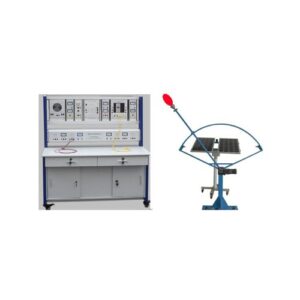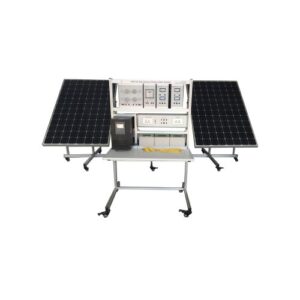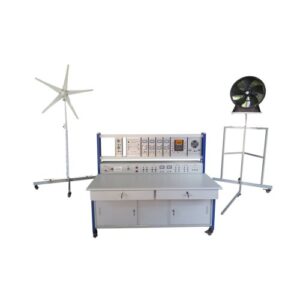AZM2101 Solar Energy Modular Trainer Vocational Training Equipment Renewable Training Equipment
The trainer must correspond to a system for the study of the electrical installations with off grid photovoltaic solar energy.
It must be composed of a photovoltaic inclinable module, 90 W, 12 V, complete with a cell for measuring the solar irradiation and with a temperature sensor and a supporting frame for the following modules:
- battery protection module, 12 V, 32 A with the following components:
-32 A circuit breaker for control of the battery,
-LED indicator for the battery connection,
-4 mm security terminals black/red.
- a rheostat module including knob for varying the resistance and terminals. Range: 0-80 Ω.
- measuring instrument module to perform measurements of a photovoltaic system. It must include a series of instruments; input terminals +/- are placed on the left of each instrument and the output terminals must be on the right. It must provide DC, AC and environmental measurements. All instruments must show readings using the automatic decimal point position, starting from 1/1000 up to the maximum value of each measurement. Communication terminals must be located on the right low side of the panel; two ARS485 connectors, one male and one female, must be available for the connection with the PC running the acquisition software and/or with other modules in a chain configuration. Instruments must support MODBUS RTU protocol over ARS485 interface, used by the software application, available separately, to perform a guided analysis of the electrical characteristics on the modules of the trainer. The module must include 4 multifunction displays:
-No.2 for DC measurements and displaying data for Voltage, Power and Current: DC voltage ± 65V, DC current ± 30A, DC power autoscale,
-No. 1 display for AC measurement: AC voltage 0-512V, AC current ±30A, Power Meter,
-No. 1 display showing data for: Solar irradiance meter 0 ÷ 1000 W/m2, Thermometer 0 ÷ 400°C.
Connections of the Measuring Instrument Module:
-Connector for the calibrated cell and for the temperature sensor.
-Power supply connectors of the module: DC voltage must be between 10V and 35V.
-Power switch, for the module switching on/off.
-Connectors for DC signals measuring voltage, current and power.
-Connectors for AC signals measuring.
-RS 485 Communication port, for the SW application interface.
- charge regulation module for charge regulation of the battery with the current supplied by the solar panel, it must include LCD screen to provide information on situations; the module must have protection against overload, temperature compensation, different charge modes of the battery (slow, fast, maintenance mode, etc), DC solar panel terminals, DC battery terminals & DC load terminals. Characteristics:
-Maximum charge current 30 A,
-Short-circuit current 30 A,
-Input voltage 12 V,
-Protection AIP22.
- load module with two 12V lamps, dichroic and LED; each lamp must incorporate an on/off control independent switch and 2 DC terminals.
- load module with two AC loads (230 V, 50 Hz). The upper one shall be a halogen lamp, and the lower one a LED lamp and 2 AC terminals.. They can be switched on/off independently.
- DC to AC inverter module, it must include control circuits against the output overload and against the deep discharge of the battery, rated power: 300 W, input voltage: 10.5-16V. The module must have DC terminals, on/off indicator, battery low or output overload indicator and mains terminals. It also must include the following connectors and indicators:
-DC 12 V – DC feed at the indicated voltage,
-ON – Status: on when the inverter is active,
-Low Battery & Overload – Status: battery low or output overload,
-MAINS – Output of the mains (230 Vac).
- Battery module.
With this didactic system it shall be possible to perform the following experiments:
Basics of the Solar Trainer:
- Identification of the components of the trainer
- Measuring the load current, voltage and power
Irradiation and Temperature Measurements:
- Setting the solar panel to the most irradiated position
- Changing the inclination of the solar panel
- Changing the azimuth of the solar panel
- Covering the solar panel with different materials
Solar Irradiation throughout the Day:
- Obtaining the solar irradiation data
Solar Panel Voltage-Irradiation Curve, Current-Irradiation Curve and Resistance of the Solar Panel:
- Obtaining the solar panel voltage-irradiation curve
- Calculating the inner resistance of the solar panel
Current-Voltage Characteristics of the Solar Panel:
- Obtaining the solar panel current-voltage curve
Solar Panel Power Measurements:
- Obtaining the solar panel current-power curve
- Overloaded solar panel measurements
Using Solar Panel to Charge the Battery:
- Battery charging
Using Solar Panel and Battery to Power DC Load:
- Supplying DC load
Using Solar Panel and Battery to Power AC Load:
- Supplying AC load.
The modules must be insulated type and it must be possible to mount them on a two level vertical frame supplied with the system.
The trainer must include a processing software designed in labview.
The trainer must be supplied with a set of interconnecting wires and manual in English language.











